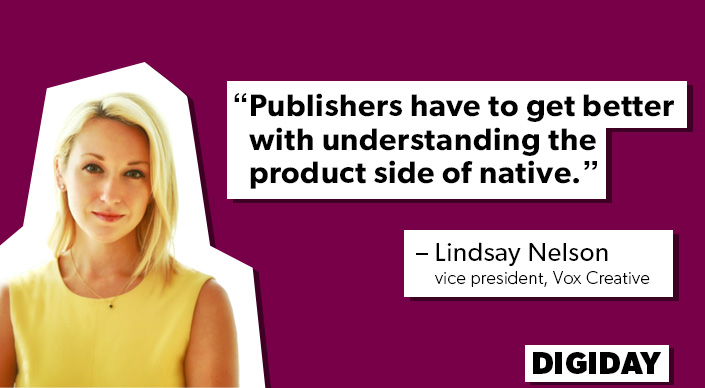Save 50% on a 3-month Digiday+ membership. Ends Dec 5.

Vox Media is awash in venture capital. The question now is whether it can make the revenue to justify the cash investors have poured into it.
The 11-year-old media company said on Monday that it’s raised another $46.5 million in funding, bringing its total to $107.6 million since its first round in 2008. Investors value the company at $380 million, half the valuation of BuzzFeed but $100 million more than the what Amazon CEO Jeff Bezos paid for the Washington Post last year.
At at the same time, Vox Media also said that it has hired Lindsay Nelson, the founder of Slate’s content studio, to head up VoxCreative, Vox Media’s own in-house marketing and advertising unit. Sponsored content is the in-vogue cash grab for publishers like The New York Times, Wall Street Journal and Huffington Post, all of which are looking to content studio businesses to offset the ongoing revenue crunch in display advertising. Vox Media hopes that Vox Creative will help it turn a profit in 2015.
In an interview with Digiday, Nelson talked about the changing face of sponsored content, how publishers typically bungle it, and why Vox Media’s Chorus CMS is going to be at the core of its attempts to scale its business and justify its valuation.
You Started Slate Custom in 2012, way before most publishers were looking at native advertising. How has the space changed since then?
Three years ago, when I started at Slate, “native advertising” as a term didn’t exist, which is crazy because we hear about it all the time now. At Slate we called it “embedded advertising.” For the first two years everyone focused on being great storytellers. They built teams and became experts in finding that line between great storytelling while pushing the messages that are valuable to advertisers.
But you don’t think that’s enough anymore.
What’s happened in the last year is what I believe is going to be the most critical divide between those that putter along in the space and those and those who are going to be understood as the leaders: Publishers have to get better with understanding the product side of native.
How so?
You develop amazing story or video series but the question now is around how you marry that creation with an ability to think about distribution and scale and measurement. The only way to do that is to get an intimate understanding about how people are engaging with native advertising on your site. What do they like? When do they leave? How do you get them to come back? That territory is open right now and with the DNA of Vox, there is no better company to solve that.
Ad position: web_incontent_pos1

So it’s not just cranking out content for brands.
You need to think about the entire ecosystem. Of course you’re going to need to be great storytellers and create things that help advertisers with the goals that they have for that quarter. But in order to scale that into a big business, you have to understand the entire environment around that content. You have to understand the environment on your own site, but also how you can reach the same audience when they’re not on your site. How do you connect with them when they’re on YouTube, Instagram and Twitter? That to me is native advertising 2.0, and I don’t think that most publishers can do it. Most are still dipping their toes into the business.
A lot of publishers think of sponsored content pretty transactionally: You give us money, we create five articles for you. Does that dynamic need to change?
If I were an advertiser, I would want to know at the end of a campaign whether I should do it again. That’s one part. On the other side, we’re trying to become a consulting partner, where we help brands and guide them to develop a content marketing strategy that is 12-months long and might start on our properties and then move off them. We want to take more of that consultive approach rather than just throw up some sponsored posts.
How do you scale this? There’s always a production bottleneck with branded content. You may want to work with five advertisers at a time, but only have the resources and infracture for two.
From a competitive advantage, it’s all about our technology platform. It’s building out a CMS platform that’s flexible and that has the same capabilities of editorial. It’s turnkey, and it’s going to be way more efficient than increasing production management process that are going to buy you a few extra hours.
So that’s the pitch for Chorus, your CMS? You’re basically selling advertisers on the idea that they can create sponsored content quickly?
From an advertiser’s standpoint you can go from concept to publication in a much narrower time, and you can do that much more efficiently so you can get the volume. You can also be reactive. If there’s something in the news that a brand wants to be close to you can get them up and running with the same type of polish that they would expect from advertising that takes much longer.
More in Media

Digiday+ Research Subscription Index 2025: Subscription strategies from Bloomberg, The New York Times, Vox and others
Digiday’s third annual Subscription Index examines and measures publishers’ subscription strategies to identify common approaches and key tactics among Bloomberg, The New York Times, Vox and others.

From lawsuits to lobbying: How publishers are fighting AI
We may be closing out 2025, but publishers aren’t retreating from the battle of AI search — some are escalating it, and they expect the fight to stretch deep into 2026.

Media Briefing: Publishers turn to vertical video to compete with creators and grow ad revenue in 2026
Publishers add vertical video feeds to their sites to boost engagement, attract video ad spend and compete with news creators.
Ad position: web_bfu


